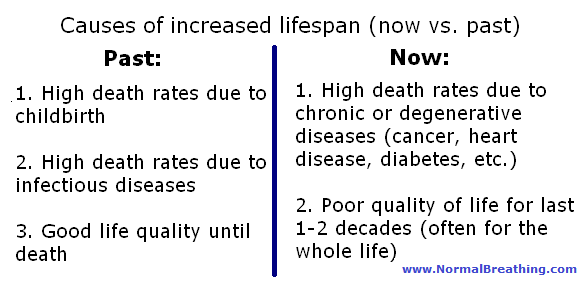- Updated on September 15, 2020
![]() By Dr. Artour Rakhimov, Alternative Health Educator and Author
By Dr. Artour Rakhimov, Alternative Health Educator and Author
Mortality Rates (Causes of Death): Past vs. Now
It was a common question that I was asked many times by my students and during lectures about mortality rates, “If people in the past had much better results for the body oxygen test, why life expectancy is higher now than it was 100 years or a century ago?”. In other words, they asked if increased body O2 due to easier breathing should cause increased lifespan and reduced mortality rates.
Indeed, if we consider clinical evidence for the body O2 test (CP test), we can see that now ordinary people have about 20-25 s, while 80-100 years ago in our history, it was common to find 40-50 s or nearly 2 times more. From the graph on the Homepage of this site, we see that ordinary people breathed nearly 2-3 times less air than modern people. Why then do we live longer than people living about 70-100 years ago and before?
Causes of death and mortality in the past
The causes of deaths or mortality profiles were very different in the recent historical past (80-100 years ago or centuries ago vs. recent times).
A. In the past, mortality at birth (for mothers and babies) was much higher than now
Note that, from a statistical or mathematical viewpoint, having babies (0 years old) and females (in average, in their 20s) die, produces a large impact on average lifespan for the population. In total, these deaths were over 5% for 100 of childbirths. (Source: British maternal mortality in the 19th and early 20th centuries, Journal of Royal Society of Medicine, 2006 November; 99(11): p. 559–563.)
“It was not until around 1935, when antibiotics and transfusions were introduced, that a sharp reduction in the maternal mortality rate occurred. In 1900, maternal mortality was about 65 times higher than it is today, and not much lower than it had been in the mid-nineteenth century…” (Source: “Childbirth in Early America”).
“Prior to 1900, infant mortality rates of two and three hundred [per 1,000 births] obtained throughout the world. The infant mortality rate would fluctuate sharply according to the weather, the harvest, war, and epidemic disease. In severe times, a majority of infants would die within one year [then the surviving babies should live nearly 2 times longer (!) to maintain the same population’s average life expectancy]. In good times, perhaps two hundred per thousand would die.” (Source: Infant Mortality and Life Expectancy).
B. Mortality due to infectious diseases in adults was much higher as well.
“Infectious disease mortality declined during the first 8 decades of the 20th century from 797 deaths per 100000 in 1900 to 36 deaths per 100000 in 1980.” (Source: Trends in infectious disease mortality in the United States during the 20th century, Armstrong GL, Conn LA, Pinner RW, Journal of American Medical Association, 1999 Jan 6;281(1):. 61-66.)
What about causes of death in modern times? This is how Wikipedia describes the changes in death profiles or causes of death:
Cause of Death (changes during the 20th century)
“Throughout the 20th century in the developed world, the leading causes of death transitioned from infectious diseases such as influenza to degenerative diseases such as cancer or diabetes.” You can read more from this Wiki article: http://en.wikipedia.org/wiki/Death_rates_in_the_20th_century#Cause_of_Death.
Life quality (past or centuries ago vs. now)
Finally, there is one more factor related to the quality of life during last years of life. In the past, due to a variety of causes, most people were working hard nearly until their death. There was no advanced health care and methods to make elderly people last longer.
What about life quality for elderly during their last 10-20 years, often as soon as a person retires? For modern times, we know that millions of people (likely more than 50%) have a miserable life quality due to symptoms and diseases for last 1-2 decades of their lives.
These details are summarized in this graph.

Breathing retraining allows to greatly improve personal lifestyle and quality of life. Have you found Buteyko and breathing useful? Spread the word to end pain, misery and high mortality due to chronic diseases.

